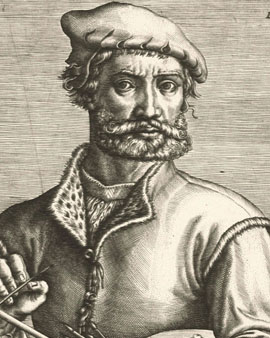Whether Pieter Coecke van Aelst was a genius can no longer be said from today's perspective. One thing is certain, however: he was a widely travelled man, an intellectual entrepreneur and a gifted translator, who apparently spoke several languages and translated specialist literature from Italian into German, Flemish or French. He was a painter, architect, author, sculptor - in short, an artist. He created paintings in the lush and detailed style of his time. Among his works, which received much attention and are still admired today, is "The Last Supper" - a triptych. It is said that he was inspired by Leonardo Da Vincis version of this motif. Also influences of Albrecht Dürer are said to be found in this special work. The painting was copied umpteen times in his studio by assistants and was probably a kind of bestseller in the 16th century. Pieter Coecke van Aelst undoubtedly belonged to the established artist scene of his time. He designed tapestries, had them made in small production centres and the rulers of his time appreciated his tapestry design. It is no coincidence that he was also court painter to Charles V in the meantime.
Pieter Coecke van Aelst was born in Aalst on 14 August 1502, the son of the deputy mayor and therefore certainly in wealthy circumstances. Not much is known about his childhood. Van Aelst studied painting in Brussels with experts on the Renaissance scene. He went on educational trips to Italy, spent a long time in Turkey and tried to serve the Sultan in Constantinople. All these influences were later naturally incorporated into his art. Through his work as a translator of Italian textbooks on architecture - so it is said - he established the subject of the Renaissance in the country. The Italian influence should be clearly visible in his figures. The very productive van Aelst certainly mastered the marketing of his art in all its forms. He was married twice. He had five children from the two marriages, but he is also said to have had two illegitimate children. Pieter Coecke van Aelst died in Brussels on 6 December 1550 at the age of 48.
×





_Vanity_(ho_-_(MeisterDrucke-1317375).jpg)
_Vanity_(ho_-_(MeisterDrucke-1317375).jpg)
_Eighth_tapestry_i_-_(MeisterDrucke-1321701).jpg)
_Eighth_tapestry_i_-_(MeisterDrucke-1321701).jpg)
.jpg)
.jpg)
.jpg)
.jpg)
.jpg)
.jpg)
.jpg)
.jpg)
_-_(MeisterDrucke-1317160).jpg)
_-_(MeisterDrucke-1317160).jpg)
 - (MeisterDrucke-150036).jpg)
 - (MeisterDrucke-150036).jpg)
 know as The Trinity - (MeisterDrucke-18551).jpg)
 know as The Trinity - (MeisterDrucke-18551).jpg)
.jpg)
.jpg)
_Vanity_(ho_-_(MeisterDrucke-1317148).jpg)
_Vanity_(ho_-_(MeisterDrucke-1317148).jpg)
.jpg)
.jpg)
_Eighth_tapestry_i_-_(MeisterDrucke-1317105).jpg)
_Eighth_tapestry_i_-_(MeisterDrucke-1317105).jpg)
.jpg)
.jpg)
.jpg)
.jpg)
_Peinture_de_Pieter_Coecke_van_A_-_(MeisterDrucke-1325377).jpg)
_Peinture_de_Pieter_Coecke_van_A_-_(MeisterDrucke-1325377).jpg)
_Vanity_(ho_-_(MeisterDrucke-1319309).jpg)
_Vanity_(ho_-_(MeisterDrucke-1319309).jpg)
.jpg)
.jpg)
.jpg)
.jpg)
.jpg)
.jpg)
.jpg)
.jpg)
_Vanity_(ho_-_(MeisterDrucke-1317149).jpg)
_Vanity_(ho_-_(MeisterDrucke-1317149).jpg)
.jpg)
.jpg)
_know_as_Th_-_(MeisterDrucke-875519).jpg)
_know_as_Th_-_(MeisterDrucke-875519).jpg)
.jpg)
.jpg)
.jpg)
.jpg)
 - (MeisterDrucke-561574).jpg)
 - (MeisterDrucke-561574).jpg)
_-_(MeisterDrucke-1319311).jpg)
_-_(MeisterDrucke-1319311).jpg)
.jpg)
.jpg)
.jpg)
.jpg)
.jpg)
.jpg)
 - (MeisterDrucke-558973).jpg)
 - (MeisterDrucke-558973).jpg)
.jpg)
.jpg)
.jpg)
.jpg)
 - (MeisterDrucke-52833).jpg)
 - (MeisterDrucke-52833).jpg)
.jpg)
.jpg)
.jpg)
.jpg)
.jpg)
.jpg)
.jpg)
.jpg)
.jpg)
.jpg)
.jpg)
.jpg)
.jpg)
.jpg)
 - (MeisterDrucke-312).jpg)
 - (MeisterDrucke-312).jpg)
.jpg)
.jpg)
.jpg)
.jpg)
.jpg)
.jpg)
.jpg)
.jpg)
.jpg)
.jpg)
_Apres_le_dernier_souper_l_-_(MeisterDrucke-1320604).jpg)
_Apres_le_dernier_souper_l_-_(MeisterDrucke-1320604).jpg)
.jpg)
.jpg)
_-_(MeisterDrucke-1440701).jpg)
_-_(MeisterDrucke-1440701).jpg)
.jpg)
.jpg)
.jpg)
.jpg)
.jpg)
.jpg)
.jpg)
.jpg)
.jpg)
.jpg)
.jpg)
.jpg)
.jpg)
.jpg)
_-_(MeisterDrucke-1120902).jpg)
_-_(MeisterDrucke-1120902).jpg)
.jpg)
.jpg)
_-_(MeisterDrucke-1317260).jpg)
_-_(MeisterDrucke-1317260).jpg)
 - (MeisterDrucke-50118).jpg)
 - (MeisterDrucke-50118).jpg)
.jpg)
.jpg)
_-_(MeisterDrucke-1317261).jpg)
_-_(MeisterDrucke-1317261).jpg)
.jpg)
.jpg)
_-_(MeisterDrucke-1317263).jpg)
_-_(MeisterDrucke-1317263).jpg)
 - (MeisterDrucke-556497).jpg)
 - (MeisterDrucke-556497).jpg)
.jpg)
.jpg)
.jpg)
.jpg)
.jpg)
.jpg)
.jpg)
.jpg)
_Verso-_Youth_from_Th_-_(MeisterDrucke-876663).jpg)
_Verso-_Youth_from_Th_-_(MeisterDrucke-876663).jpg)
_Vanity_(ho_-_(MeisterDrucke-1317150).jpg)
_Vanity_(ho_-_(MeisterDrucke-1317150).jpg)
.jpg)
.jpg)
.jpg)
.jpg)
.jpg)
.jpg)
.jpg)
.jpg)
.jpg)
.jpg)
.jpg)
.jpg)
.jpg)
.jpg)
.jpg)
.jpg)
.jpg)
.jpg)
_-_(MeisterDrucke-1321946).jpg)
_-_(MeisterDrucke-1321946).jpg)
_-_(MeisterDrucke-1420264).jpg)
_-_(MeisterDrucke-1420264).jpg)
.jpg)
.jpg)
_Peinture_de_Piete_-_(MeisterDrucke-1325988).jpg)
_Peinture_de_Piete_-_(MeisterDrucke-1325988).jpg)
.jpg)
.jpg)
_-_(MeisterDrucke-1317262).jpg)
_-_(MeisterDrucke-1317262).jpg)
.jpg)
.jpg)
.jpg)
.jpg)
.jpg)
.jpg)
.jpg)
.jpg)
.jpg)
.jpg)
 - (MeisterDrucke-92610).jpg)
 - (MeisterDrucke-92610).jpg)
.jpg)
.jpg)
.jpg)
.jpg)
.jpg)
.jpg)
_-_(MeisterDrucke-1440476).jpg)
_-_(MeisterDrucke-1440476).jpg)
.jpg)
.jpg)
.jpg)
.jpg)






